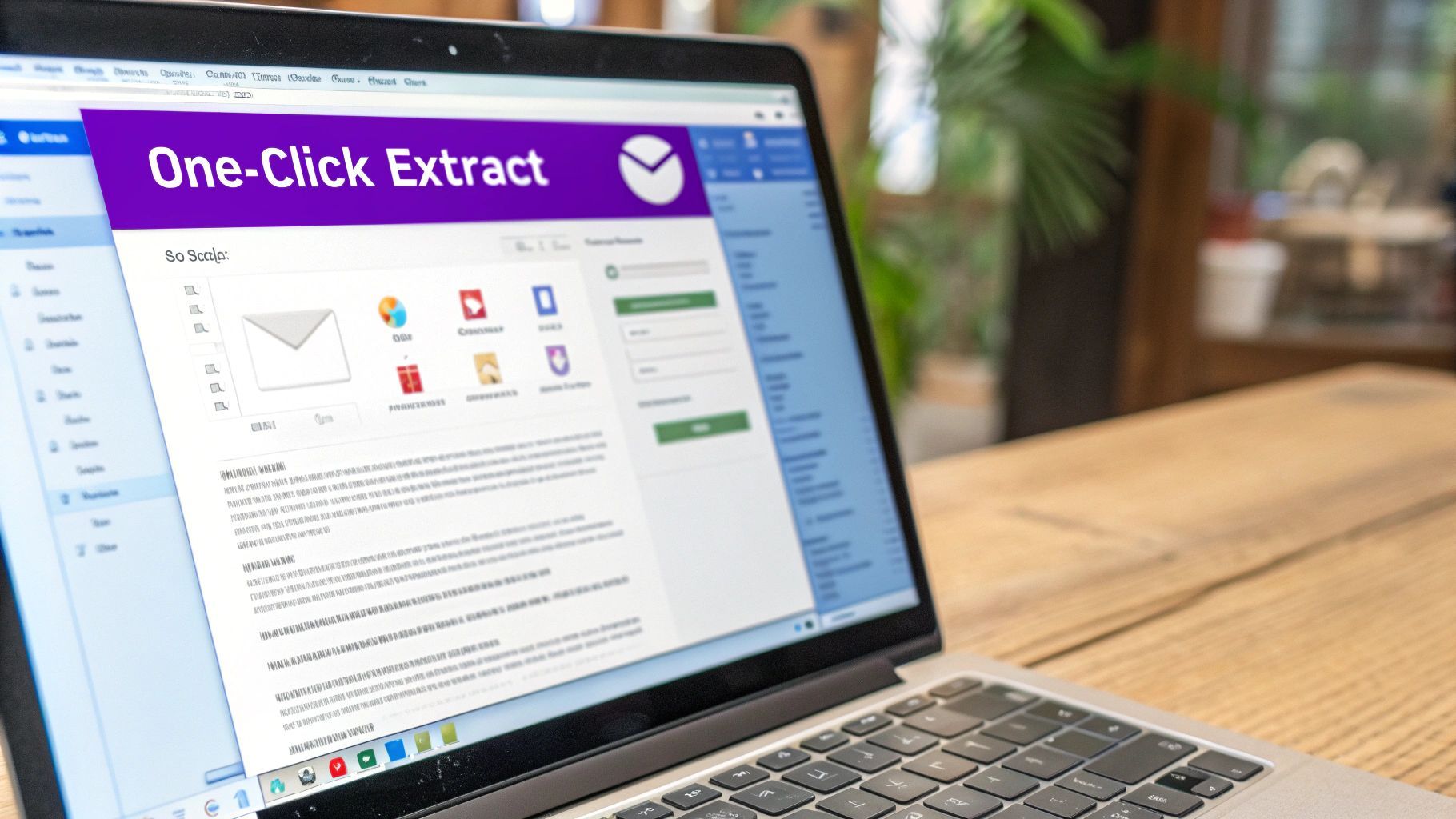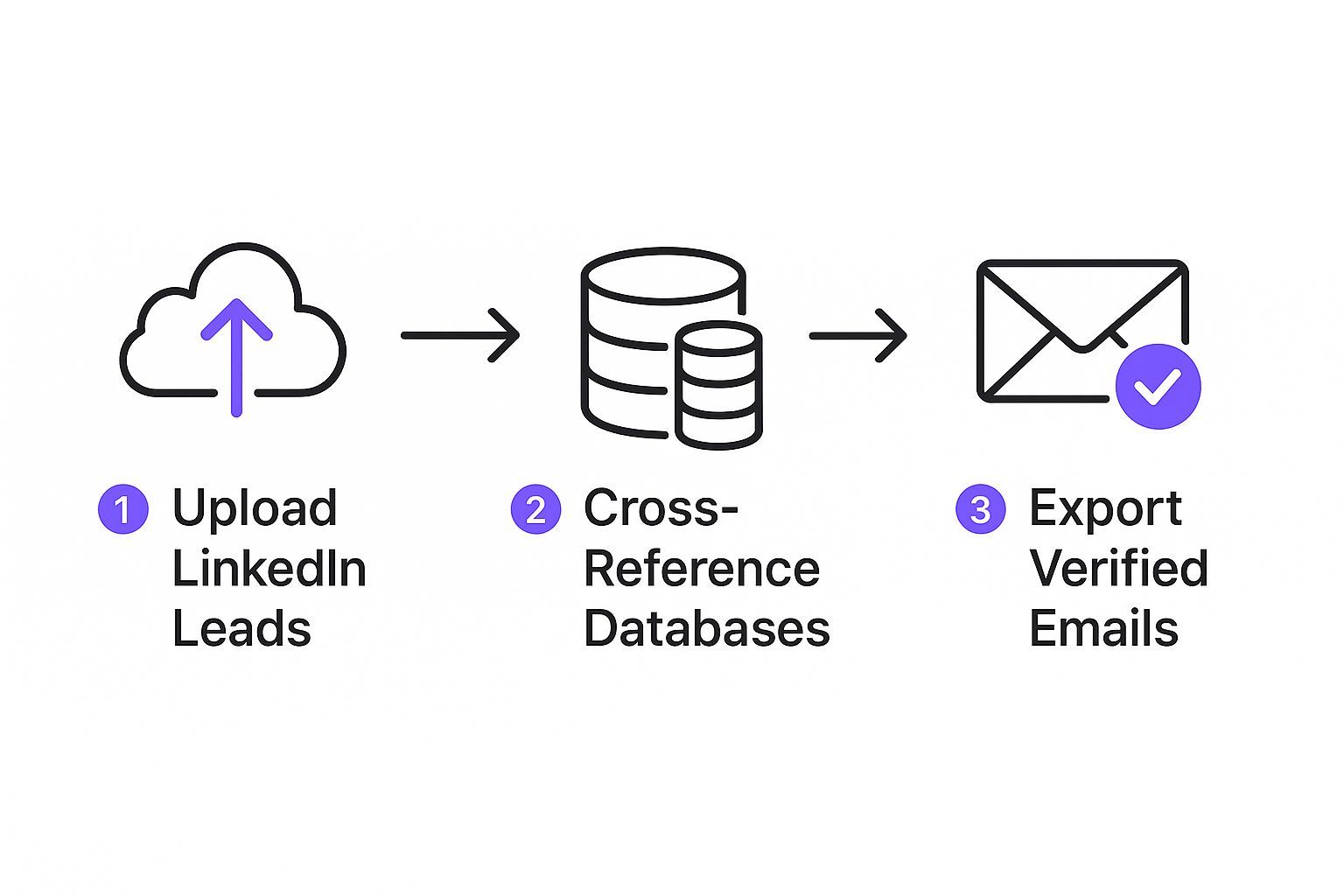So, you need to find someone's email on LinkedIn. The most obvious place to look is the "Contact Info" section on their profile, but let's be real, it's often empty. Sometimes you get lucky and find it tucked away in their "About" section or even on a custom banner image. For a more direct and scalable approach, though, you'll want to look at tools built specifically for the job.
Your Playbook for Finding Emails on LinkedIn

LinkedIn is the holy grail for professional connections. But turning a profile view into a real conversation means you need an email address. If you're in sales, recruiting, or marketing, you know this struggle all too well—it's a massive bottleneck that slows down your outreach and kills momentum. This guide is here to fix that, cutting through the noise of manual searches and flaky automation.
Why Direct Emails Still Matter
Sure, InMail has its place. But a direct email just hits differently. It feels more personal and professional, landing right in the inbox where real business gets done. It also gives you full control over formatting, letting you attach files and track opens and clicks. When the outreach is important, an email is essential.
The big problem is that LinkedIn keeps email addresses under lock and key for most users. This means you need a solid strategy that blends some old-fashioned detective work with smart, efficient tech. We're going to cover both angles:
- Manual Techniques: Perfect for high-value targets when you absolutely need to be accurate.
- Automated Solutions: The go-to method for building targeted prospect lists at scale without trashing your data quality.
One of the best manual tricks is also the simplest: a thorough profile inspection. Some studies suggest that roughly 15-30% of LinkedIn users actually list their email publicly in places like their 'Contact Info', 'About', or even 'Experience' sections. That number might seem low if you're building a massive list, but for targeted outreach, it's a goldmine. It gives you a 100% accurate, user-verified email. This method costs you nothing but a bit of your time and ensures you're using info they've willingly shared. You can dig deeper into manual discovery techniques over at SalesRobot.co.
Think of this guide as your go-to playbook for finding the contact info you need to build real, meaningful professional relationships.
Mastering Manual Searches for Key Contacts

Sometimes, you need to be 100% sure you have the right email, especially for a high-value prospect. For those mission-critical contacts, nothing beats a little old-fashioned detective work.
While automated tools are fantastic for building lists at scale, a hands-on approach guarantees you're working with information the prospect has shared themselves. This doesn't just improve accuracy; it often means you're using an inbox they actually monitor.
Forget just clicking the "Contact Info" button. You have to think like an investigator, scanning every inch of a profile for clues. Many savvy professionals—think consultants, founders, and sales leaders—deliberately place their contact details where they’ll get noticed.
Places to Manually Check on a Profile
Start with the most obvious spots, then get creative. Here’s my go-to checklist for hunting down an email on someone's LinkedIn profile:
- The 'About' Section: This is their personal elevator pitch. I’ve found that many people drop their email address or a link to their personal website right at the end with a call to action.
- The Custom Banner Image: That big header image at the top? It's prime real estate. Marketers and entrepreneurs often use it to display their company site, social handles, or even their direct email. It's surprising how often people miss this.
- Recent Posts and Articles: Take a quick scroll through their activity feed. If they’ve recently promoted a webinar, launched a new service, or asked for collaborators, there's a good chance they included a way to get in touch.
Pro Tip: Don't just scan for the "@" symbol. I've had more luck searching for conversational phrases like "reach me at," "get in touch," or "for inquiries." People often write it out naturally instead of just dropping a raw email address.
Guessing and Verifying Email Patterns
If you’ve searched the profile and come up empty, the next logical step is to make an educated guess. Most companies follow a standard email format, which makes things a bit easier.
First, you need the company’s domain (like acme.com). From there, you can test out the most common email patterns using the person’s name. I usually start with these:
firstname.lastname@company.com(e.g., jane.doe@acme.com)flastname@company.com(e.g., jdoe@acme.com)firstname@company.com(e.g., jane@acme.com)
Once you have a list of possibilities, run them through a free email verification tool. This is a crucial step. Skipping it can lead to bounced emails, which tanks your sender reputation.
While this method is solid for a few key contacts, it becomes a huge time sink when you’re serious about prospecting on LinkedIn. The manual data entry, the pattern guessing, and the verification checks for even a small list can eat up hours of your day.
This is exactly the kind of bottleneck that modern, no-code scraping tools like ProfileSpider were built to solve. They turn a painstaking, multi-step research project into a simple, one-click action.
The One-Click Solution: Finding Emails with ProfileSpider
When you need to fuel your pipeline and manual searching just isn't cutting it, you need a smarter approach. Traditional methods are a drag—you either spend hours clicking through profiles one by one, a method that's impossible to scale, or you wrestle with clunky automated tools that demand complex setups and deliver questionable data.
This is exactly where a modern, no-code tool like ProfileSpider completely changes the game. It’s built for busy recruiters, sales pros, and marketers who need accurate data, fast, without becoming a tech wizard overnight. Instead of juggling a half-dozen different tools or losing an afternoon to manual grunt work, ProfileSpider boils the entire process down to a single click.
One-Click AI Profile Extraction
Picture this: A sales professional runs a LinkedIn search for "VP of Marketing in SaaS" and gets a screen full of perfect leads. The old way? Click. Copy. Paste. Repeat. For hours.
The ProfileSpider way? Just click the extension icon.
In a few seconds, its AI-powered engine scans the whole page, pulling every profile's name, title, company, location, and any contact info it can find. All of that data is instantly organized into a clean, simple list, right inside your browser. This one-click workflow turns hours of mindless data entry into a task that takes less time than making a cup of coffee. You can explore more about LinkedIn prospecting automation to see how this fits into a larger strategy.
This screenshot shows exactly what I'm talking about. The ProfileSpider extension is open on a LinkedIn search results page, capturing a dozen profiles in an instant.

What you’re seeing there is the core magic of ProfileSpider—it transforms a static webpage into a structured, exportable database without you having to lift a finger.
Works Everywhere, Keeps Your Data Private
While a lot of tools are built exclusively for LinkedIn, your best prospects and candidates are all over the web. ProfileSpider's universal extraction engine is designed to work on pretty much any website with profile information. Think Twitter, GitHub, niche industry forums, or even company "About Us" pages. No special configuration is needed. You just click and extract.
Even more important is ProfileSpider's privacy-first approach. Every piece of data you extract is stored locally in your browser's IndexedDB.
This is a huge deal. Your lead lists and candidate databases are your proprietary assets. ProfileSpider makes sure they are never sent to external servers without your say-so, giving you total control and keeping you GDPR compliant.
This local storage model means your data is secure, private, and always accessible, even if you’re offline.
Smart Organization for Pro Workflows
Just collecting data isn't enough. You need to organize it to make it useful. ProfileSpider gets this and includes the smart management features that professionals actually need.
- Custom Lists: Keep profiles organized by project, campaign, or job role.
- Tags and Notes: Add your own labels and notes for context and easy filtering.
- Advanced Search: Find that one specific profile you saved weeks ago in seconds.
- Professional Exports: Export your lists to CSV, JSON, or Excel, ready to be dropped right into your CRM, Applicant Tracking System (ATS), or any other outreach tool you use.
Here’s a quick rundown of how these different email-finding methods stack up against each other.
Email Finding Methods Compared
| Feature | Manual Search | Traditional Scrapers | ProfileSpider |
|---|---|---|---|
| Speed | Extremely slow, one-by-one | Can be fast, but often requires setup | Instant, single-click extraction |
| Scalability | Not scalable at all | Moderately scalable, but complex | Highly scalable for any workflow |
| Accuracy | Prone to human error | Varies wildly, often outdated | AI-verified and consistently accurate |
| Privacy | Secure (on your machine) | Often stores your data on their servers | 100% private, local browser storage |
| Ease of Use | Simple, but tedious | High learning curve, requires setup | No-code, works out of the box |
| Website Support | Any website | Usually limited to specific sites | Universal, works on almost any site |
As you can see, ProfileSpider really hits the sweet spot between power, privacy, and ease of use, which is a rare find. By combining powerful AI extraction with features that are genuinely useful for day-to-day work, ProfileSpider removes the technical roadblocks to finding anyone's email on LinkedIn. It turns data collection from a time-sucking chore into a real strategic advantage.
If you want to see exactly how these features click together, you can check out a detailed ProfileSpider deep-dive. It’s the perfect no-code scraping tool for any sales pro, recruiter, or marketer who values their time and needs data they can trust.

Staying Ethical With Your Outreach
Finding an email is really just the starting line. How you use that email is what separates a successful campaign from one that gets you blacklisted. Once you’ve figured out how to find someone's email from LinkedIn, your entire strategy has to be built on responsible, ethical practices.
This isn't just about ticking boxes for regulations like GDPR and CAN-SPAM. It's about respecting the person on the other end. Blasting out a generic, high-volume email campaign is the fastest way to get your messages marked as spam, tank your sender reputation, and maybe even get your domain blacklisted for good.
Best Practices for Responsible Outreach
To make sure your outreach actually works—and doesn't burn bridges—build these habits into your workflow:
- Personalize Every Single Message: "Dear Sir/Madam" is an instant delete. Show you’ve done your homework. Mention their specific role, a recent project they worked on, or a mutual connection you share. It makes all the difference.
- Lead with Value, Not a Sales Pitch: Don't come in hot with a hard sell. Your first touchpoint should offer something genuinely useful—a helpful resource, an interesting observation about their industry, or a potential solution to a problem they've mentioned online.
- Make Opt-Outs Obvious and Immediate: Always give people an easy way to unsubscribe. Honoring those requests instantly is non-negotiable. It’s a fundamental part of maintaining a healthy sender reputation.
After you’ve got your list of contacts, brushing up on email subject line best practices is the next logical step. A great subject line is key to getting your carefully crafted message opened in the first place.
Why Data Privacy and Verification Matter
How you handle data is just as critical as the emails you write. Scraping public data from LinkedIn is a powerful way to find prospects, but it’s a practice that exists in a tightly regulated space. While tools like Phantombuster help automate the extraction of public info, you have to balance that efficiency with compliance, especially as LinkedIn continues to update its policies.
This is where ProfileSpider’s privacy-first design gives you a real edge. It stores all the data you extract locally on your own machine, meaning you have complete control. Nothing gets sent to outside servers without your say-so, keeping your process in line with modern data privacy standards.
Getting the legal side of this right is absolutely crucial. To get a better handle on what responsible data collection looks like, you can dive into the details of whether website scraping is legal in our complete guide. This approach ensures your lead generation is powerful, sustainable, and fully compliant.
Got Questions? We’ve Got Answers
When you start digging for emails on LinkedIn, a few questions are bound to pop up. Is this even allowed? Which tools actually work? How do I know the emails I find are any good? Let's clear the air on some of the most common queries so you can get started with confidence.
Is It Actually Legal to Find Emails on LinkedIn?
Yes, it generally is, but the devil is in the details—specifically, your methods and your intentions. The key is to stay on the right side of ethical lines and respect privacy laws like GDPR and CCPA. If you're using publicly available info or a tool like ProfileSpider that's built with data privacy in mind, you're in the clear.
Things get dicey when you use aggressive scraping tools that violate LinkedIn's terms of service or when you take the emails you find and spam people. Always lead with transparency and respect.
The real goal here isn't just to hoard a list of emails. It's to open the door for a genuine, professional conversation. Blasting out spam is the quickest route to ruining your sender reputation and landing in hot water with regulations like the CAN-SPAM Act.
What Are the Best Tools for Finding Emails?
The "best" tool is the one that fits your workflow, but the winners always deliver on speed, accuracy, and simplicity. For most of us who aren't developers, no-code solutions are the way to go.
- ProfileSpider: This is my top pick because of its dead-simple, one-click process. It works everywhere—not just on LinkedIn—and it's designed to be private, storing all your data on your local machine, not on some random server.
- Hunter.io: A classic in the space, well-known for its domain search feature. It's great for figuring out the common email patterns at a specific company.
- RocketReach: This one taps into a massive database of contacts pulled from LinkedIn and other public sources, giving you a pretty wide net to cast.
While there are tons of options, ProfileSpider feels like it was built for today's professional—someone who just needs accurate data without a technical headache or privacy concerns.
How Can I Make Sure the Emails Are Accurate?
Finding an email is one thing; finding a valid one is another. Sending emails to dead addresses will wreck your bounce rate and can get your entire domain flagged as spam. An unverified list is a huge liability.
So, how do you check them? A couple of solid methods exist. You could use a dedicated email verification service like NeverBounce or ZeroBounce. These tools ping the email server to see if the address is live without actually sending a full email.
The best email finders, including ProfileSpider, build this verification right into the process. This means the contact info you get is not only found in seconds but is also ready to use, protecting your sender reputation right from the get-go.
Can You Pull Emails From LinkedIn in Bulk?
Absolutely, and this is where automation really flexes its muscles. Manually copying and pasting hundreds of emails isn't just slow; it's a recipe for mistakes. If you want to scale any kind of sales, marketing, or recruiting effort, bulk extraction is a must.
This is a core feature of ProfileSpider. You can run a search on LinkedIn, click one button, and watch as the tool zips through every profile on the page. It grabs their name, job title, and contact info, and puts it all into a clean list. From there, you can export the whole thing to a CSV or send it straight to your CRM. It turns what would be a full day of painful manual labor into a job that’s done in minutes.




